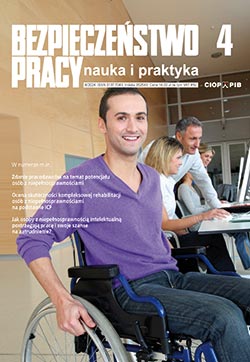Noise vs. audibility of the warning signalisation in traffic
Paweł Górski
According to the Highway Code an on-road authorized emergency vehicle should emit visual and audible signals at the same time. While for road users, an audible warning signal provides important information and its A-weighted sound pressure level is acceptable, it is a source of annoying noise to the emergency vehicle crew. Research carried out at CIOP-PIB shows that the A-weighted sound pressure levels inside an authorized emergency vehicle, with the siren enabled, increase by about 25 dB. Moving the siren of audible warning devices of emergency vehicles from the lightbar on the roof of the vehicle to the engine compartment is a common solution that reduces exposure to noise of the emergency vehicle crew, particularly the driver. This solution reduces noise inside the vehicle by about 10 dB and lowers the siren by about 2 m. This change has a significant impact on the perception of audible warning signals of authorized emergency vehicles in traffic conditions, and thus affects safety. This paper presents simulation results of changes in location and audibility of audible warning signals of authorized emergency vehicles.
Drivers’ age and psychophysical performance in scope of attributes conditioning safe participation in traffic
Anna Łuczak
This article presents an overview of the literature on age-related changes in drivers’ performance and their role in determining features of safe behaviour in traffic. Research shows that physical and mental efficiency vary significantly with age, although this is not the only determinant of the extent and pace of change. This problem is particularly important in the case of professional drivers, especially in the context of an extended retirement age.
Harmful biological agents in the working environment of airport check-in staff
Agata Stobnicka, Rafał L. Górny, Małgorzata Gołofit-Szymczak, Marcin Cyprowski, Anna Ławniczek-Wałczyk
Occupational hazards to which airport check-in staff are exposed result from contact with bioaerosols emitted from ventilation systems, and biological agents derived from passengers’ bodies, luggage and possibly animals. Airport check-in staff can be exposed to contact with harmful biological agents such as bacteria, fungi and viruses, which are responsible for numerous adverse health outcomes and diseases. Therefore, reliable risk assessment are the use of appropriate preventive measures are key aspects of occupational hazard prevention among workers in this group.
Training drivers as a way of changing their attitudes and shaping individual safety culture
Andrzej Najmiec
This article presents a training programme implemented under the National Programme “Improvement of safety and working conditions”. The aim of the programme was to modify drivers’ behaviour and their attitudes. This article presents the objectives and scope of training. It also discusses selected issues and the principles of customizing training according to individual drivers’ needs. The practical use of the programme was confirmed by 89.7%– 100% of participating drivers, depending on the evaluated area.




























